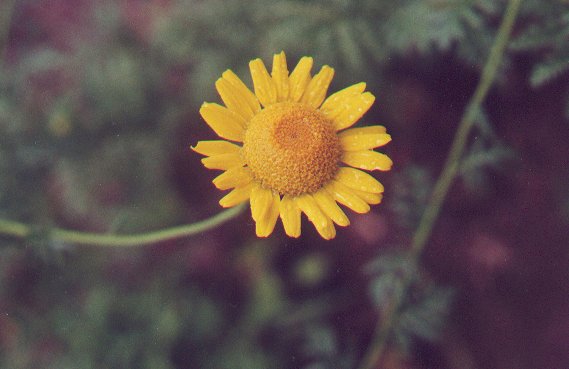Cota tinctoria ssp. subtinctoria Holub
Yellow Chamomile

Introduced
CC = *
CW = 5
MOC = 2
© DETenaglia
Cota tinctoria ssp. subtinctoria HolubYellow Chamomile | |
 |
Introduced CC = * CW = 5 MOC = 2 |
© DETenaglia |
|
Family - Asteraceae/Anthemideae Habit - Short-lived perennial forb, with short rhizomes and sometimes also stolons. Stems - To +1m tall, erect, herbaceous, multiple from base, branching above, sub-tomentose, producing stolons. Vascular tissue of stem appearing as parallel vertical lines on stem. Stems fragrant if crushed. Leaves - Alternate, mostly sessile, sparse lanate and hispidulous on upper surface, sparse lanate below, deeply pinnatifid (the main divisions again pinnately lobed). Ultimate divisions toothed and mucronate (at least on the lower leaves). Lower leaves to +/-7cm long, 3cm broad. Upper leaves shorter but slightly more broad. All leaves fragrant when crushed.
Inflorescence - Single flower head terminating stem. Involucre - Broad, flattish, 1.8cm in diameter. Phyllaries imbricate, 4-5mm long, 1.4mm broad, green with scarious margins, sparse lanate externally mostly near apex. Apices sometimes appearing lacerate.
Ray flowers - Ligules to 1.2cm long, 4-5mm broad, glabrous, truncate to emarginate at apex. Flowers fertile. Pappus none. Achene 2mm long (in flower), flattened to 4-angled. Disk flowers - Disk to 2.2cm broad and dome shaped when mature. Corolla 5-lobed, yellow. Tube to 3mm long, glabrous. Flowers fertile. Pappus none. Achene 2mm long (in flower), grayish-white, slightly 4-angled. Chaff of receptacle to 6mm long, flattened and scarious below in lower half, tapering to a terete-pointed yellow apex. Flowering - May - September. Habitat - Waste ground, fields, moist woods, also cultivated. Origin - Native to Europe. Lookalikes - None close; broadly, many species in the aster family. Other info. - This is one of several plants recognized as "Chamomile" that people like to grow and brew for tea and other uses. The plant is uncommon in the wilds of Missouri but is cultivated fairly regularly. It is found sparsely and widely scattered across portions of the northern continental U.S. The stems of the begin to lean as the plants become tall. Photographs taken at the Kansas City Zoo, 7-12-00 (DETenaglia). |